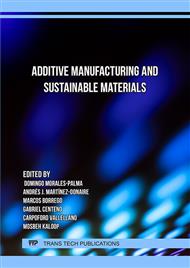[1]
M. Pankina, Ecological Aspects of Visual Urban Environment Design. KnE Soc. Sci. (2020).
DOI: 10.18502/KSS.V4I2.6349
Google Scholar
[2]
S. Amir, N. Bonifacius2, D. Poerwoningsih2. Eco-design concept of street corridors as a city image forming. IOP Conf. Ser. Earth Environ. Sci. 999 (2022).
DOI: 10.1088/1755-1315/999/1/012018
Google Scholar
[3]
G. Fusaro, F. D'alessandro, G. Baldinelli, J. Kang. Design of urban furniture to enhance the soundscape: A case study. Build. Acoust. 25:1, 61–75 (2018).
DOI: 10.1177/1351010X18757413
Google Scholar
[4]
A. M. Grabiec, A. Łacka, W. Wiza. Material, Functional, and Aesthetic Solutions for Urban Furniture in Public Spaces. Sustain. 14:23, 16211 (2022).
DOI: 10.3390/SU142316211
Google Scholar
[5]
D. Mira DASCĂLU. Landscape Effects of Urban Furniture Textures. Bull. UASVM Hortic. 68:1 (2011).
Google Scholar
[6]
K. W. M. Siu, P. H. Wan. Sustainable urban living environment: Street furniture design for an urban fishing village. The International Journal of Environmental, Cultural, Economic, and Social Sustainability: Annual Review 7:2, 167-182 (2011).
DOI: 10.18848/1832-2077/CGP/v07i02/54887
Google Scholar
[7]
F. Bilimleri Dergisi, L. Badeiy, M. Nakhaei, F. Babaoghly, N. Abhari. Some approaches in design of urban furniture with emphasis on green space use and sustainable urban landscape. Cumhur. Üniversitesi Fen Edeb. Fakültesi Fen Bilim. Derg. 36:3, 3782–3790 (2015).
Google Scholar
[8]
B.C. KurdoĞlu, M. Onur, E. BayromoĞlu. Evaluatıon of Sustaınable Urban Furnıture Wıth An Informal Desıgn. The Journal of Academic Social Science. 328–335 (2020).
DOI: 10.29228/ASOS.46633
Google Scholar
[9]
W. Zhong, T. Schröder, J. Bekkering. Biophilic design in architecture and its contributions to health, well-being, and sustainability: A critical review. Front. Archit. Res., 11: 1, 114–141 (2022).
DOI: 10.1016/J.FOAR.2021.07.006
Google Scholar
[10]
D. Parras-Burgos, J. Hernández, J. S. Velázquez, F. Cavas-Martínez, F. J. F. Cañavate, D. G. Fernández-Pacheco. Combined Urban Furniture Designed by a Bio-Inspired Approach. Lect. Notes Mech. Eng., 564–572 (2019).
DOI: 10.1007/978-3-030-12346-8_55
Google Scholar
[11]
E. Allameh, M. Heidari. Sustainable Street Furniture. Period. Polytech. Archit. 51: 1, 65–74 (2020).
DOI: 10.3311/PPAR.12674
Google Scholar
[12]
G. Faneca, T. Ikumi, J. M. Torrents, A. Aguado, I. Segura. Conductive concrete made from recycled carbon fibres for self-heating and de-icing applications in urban furniture. Mater. construcción, 70: 339, e223:1-e223:14 (2020).
DOI: 10.3989/MC.2020.17019
Google Scholar
[13]
A. Araújo, C. Caro, M. J. Mendes, H. Jaramillo, R. Gallardo, C. Martinez. Highly efficient nanoplasmonic SERS on cardboard packaging substrates Street furniture in recycled and resignified materials. IOP Conf. Ser. J. Phys. Conf. Ser. 1126, 12066 (2018).
DOI: 10.1088/1742-6596/1126/1/012066
Google Scholar
[14]
Z. Sánchez-Roldán, M. Martín-Morales, I. Valverde-Espinosa, M. Zamorano. Technical feasibility of using recycled aggregates to produce eco-friendly urban furniture. Constr. Build. Mater., 250, 118890 (2020).
DOI: 10.1016/J.CONBUILDMAT.2020.118890
Google Scholar
[15]
F. S. Al-Anzi. Building a planter system using waste materials using value engineering environmental assessment. Sci. Reports, 12., 1-17 (2022).
DOI: 10.1038/s41598-022-05300-0
Google Scholar
[16]
S. Peters, D. Drewes, Materials in Progress: Innovations for Designers and Architects, Birkhäuser, 2019.
Google Scholar
[17]
S. Batuhan Esirger, M. Ali Örnek. Recycled Plastic to Performative Urban Furniture. Full Pap. J. Digit. Landsc. Archit., 166–172 (2020).
Google Scholar
[18]
J. F. López-Aguilar, E. Sevigne-Itoiz, M. L. Maspoch, J. Peña. Is Recycled Mixed Plastic an Environmentally Effective Solution as a Replacement for Exterior Treated Wood? Combating the Myth of Down-Cycling with an Open-Loop Design Approach. SSRN Electron. J. (2022).
DOI: 10.2139/SSRN.4210248
Google Scholar
[19]
H. Zuo, M. Jones, T. Hope, R. Jones. Sensory Perception of Material Texture in Consumer Products. The Design Journal 19: 3, 405–427 (2016).
DOI: 10.1080/14606925.2016.1149318
Google Scholar
[20]
J. M. Chacón, M. A. Caminero, E. García-Plaza, and P. J. Núñez. Additive manufacturing of PLA structures using fused deposition modelling: Effect of process parameters on mechanical properties and their optimal selection. Mater. Des.124, 143–157 (2017)
DOI: 10.1016/J.MATDES.2017.03.065
Google Scholar



